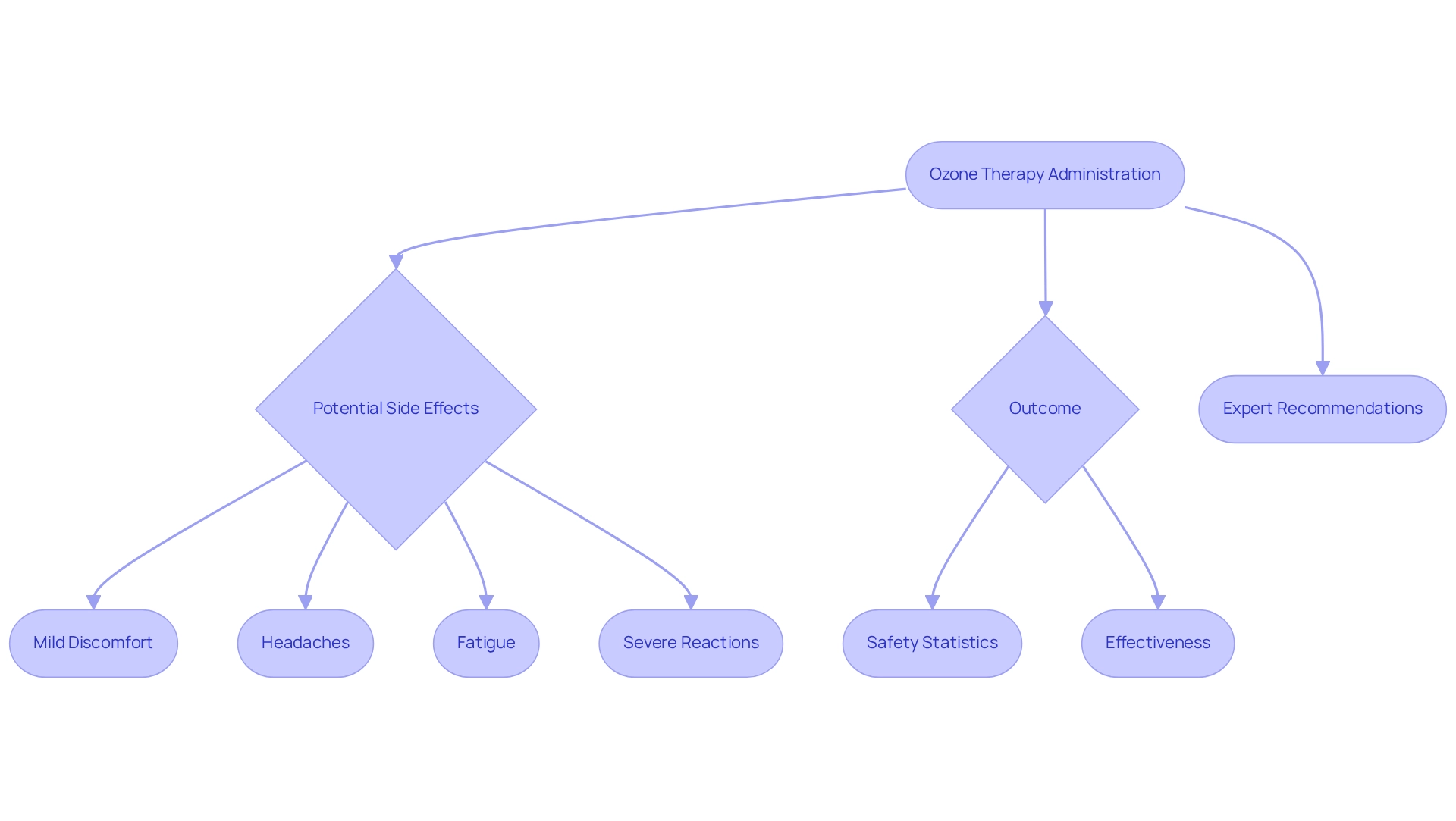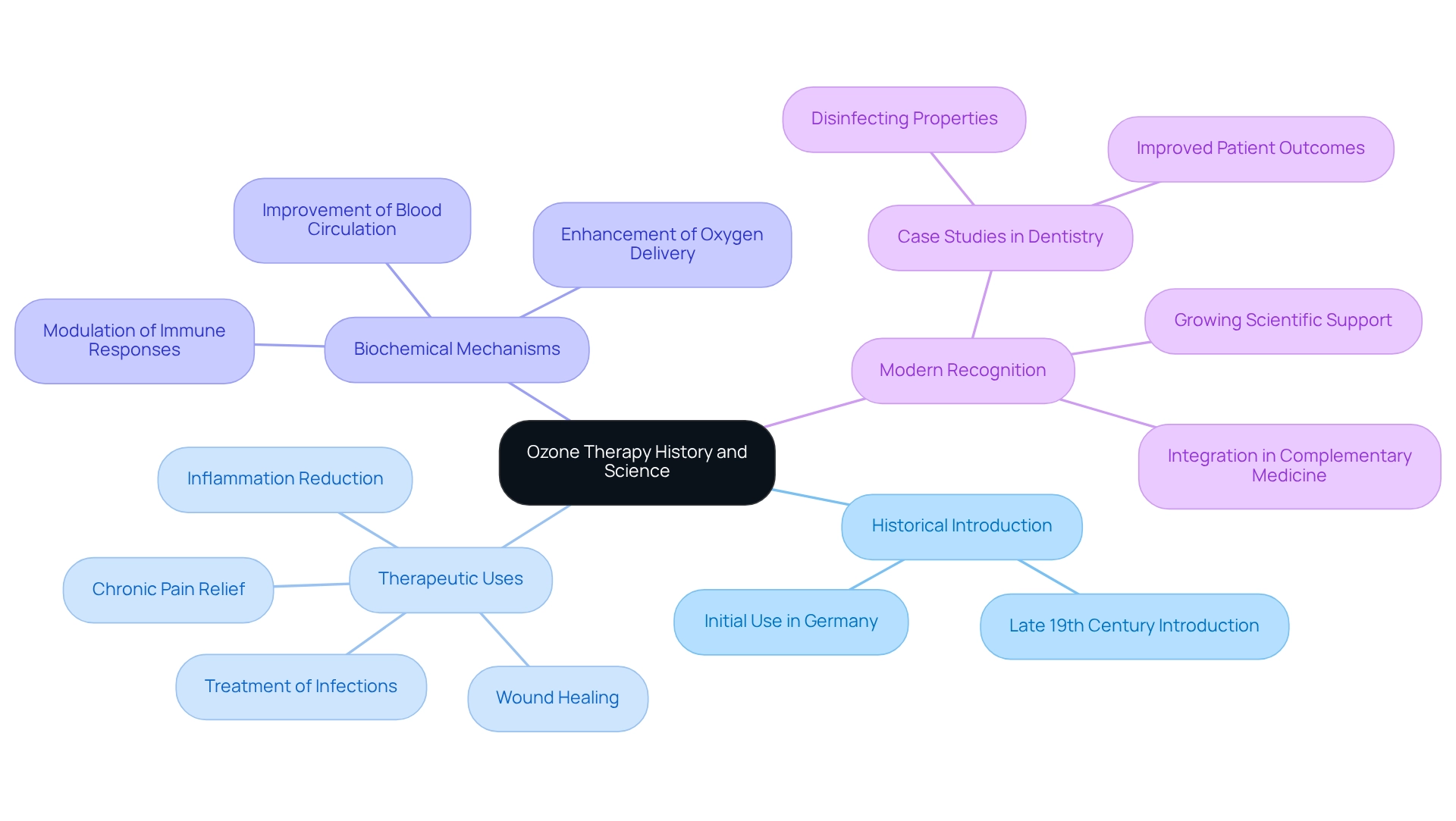Understanding the Benefits of Ozone Therapy for Health
Overview
Ozone therapy presents a range of health benefits, such as improved circulation, enhanced immune function, and pain relief for chronic conditions. This article explores its mechanisms of action, including the ability to boost oxygen delivery to tissues and modulate immune responses. Furthermore, it highlights case studies that demonstrate the therapy’s effectiveness in treating ailments like fibromyalgia and osteoarthritis.
By understanding these mechanisms, readers can appreciate how ozone therapy may serve as a valuable option for managing various health issues. As a result, exploring ozone therapy could lead to improved well-being and quality of life.
Introduction
In the quest for innovative health solutions, ozone therapy emerges as a captivating approach that leverages the unique properties of ozone gas to promote healing and enhance well-being.
With its roots tracing back to the late 19th century, this therapy has evolved into a multifaceted treatment option. It is gaining recognition for its ability to improve oxygen delivery, stimulate immune responses, and alleviate chronic pain.
As research continues to unveil its potential, ozone therapy is being explored for a variety of applications. These range from addressing inflammation and infections to rejuvenating skin and supporting overall health.
The growing acceptance of this non-surgical method highlights its significance in contemporary medicine, making it a compelling topic for those interested in the future of health and wellness.
Define Ozone Therapy: Mechanism and Applications
This treatment employs a healing method utilizing O3 gas to promote recovery and showcase the benefits of ozone therapy for overall well-being. Its mechanism of action primarily relies on the gas’s ability to improve oxygen delivery to tissues, stimulate immune responses, and enhance circulation. Various administration methods are available, including:
- Intravenous (IV) oxygen treatment
- Oxygen injections
- Topical applications
These methods showcase the benefits of ozone therapy for a wide array of conditions, such as chronic pain, inflammation, infections, and autoimmune disorders. By improving oxygen metabolism and modulating immune responses, it aims to restore physiological balance and enhance well-being. Recent studies indicate that oxygen treatment activates intracellular redox-related signaling pathways, which bolster cellular defense mechanisms, further supporting its therapeutic potential. Notably, the downregulation of ACE2 due to SARS-CoV-2 infection leads to decreased secretion of antimicrobial peptides (AMPs), resulting in increased survival of pathogens and intestinal dysbiosis. This underscores the importance of oxidative treatment in enhancing immune responses.
Case studies demonstrate the effectiveness of this treatment in alleviating chronic discomfort conditions, including fibromyalgia and osteoarthritis. One such study, titled ‘Ozone Treatment for Chronic Pain Conditions,’ reported significant pain relief and improved quality of life for patients, showcasing the method’s effectiveness in managing chronic pain. As CS from APS S.p.a. observes, this treatment represents a promising avenue for wellness enhancement, and the benefits of ozone therapy are gaining recognition as the medical field continues to explore its applications in improving well-being and recovery, establishing it as a beneficial option in modern medicine. This non-surgical approach aligns seamlessly with ByKomi.com’s commitment to anti-aging and rejuvenation strategies, offering health-conscious individuals a viable alternative treatment option.
Explore the Health Benefits of Ozone Therapy
Ozone treatment offers a broad range of health advantages, which include the benefits of ozone therapy, particularly in boosting circulation, strengthening immune function, and raising oxygen levels in tissues. Research has consistently demonstrated the benefits of ozone therapy in reducing inflammation and alleviating pain, making it a valuable option for those suffering from chronic conditions.
Significantly, the benefits of ozone therapy in oxygen treatment have shown potential in enhancing wound healing and possess antimicrobial characteristics that combat various pathogens, including bacteria, viruses, and fungi. This treatment has been effectively utilized in addressing chronic infections, Lyme disease, and respiratory ailments. Additionally, the benefits of ozone therapy, such as its ability to promote collagen creation, aid in skin renewal, positioning this treatment as a sought-after option in anti-aging routines. A single oxygen treatment session may last anywhere from 15 minutes to an hour or more, providing potential users with realistic expectations for the treatment process.
Research indicates that this gas can diminish inflammation, enhance oxygen delivery to cells and organs, and assist in strengthening immune system performance. As we approach 2025, the increasing acknowledgment of the benefits of ozone therapy is underscored by forecasts from specialists like Frank Shallenberger, who anticipates its extensive use in hospitals worldwide. This trend aligns with comprehensive wellness discussions, including insights from the case study ‘The Functional Medicine Approach to Heart Wellness,’ which emphasizes the significance of addressing overall well-being to combat heart disease effectively.
Such trends reinforce the importance of innovative interventions like oxygen-based treatment in achieving overall vitality, complementing nutritional strategies such as those involving Trimethylglycine (TMG) for methylation and cardiovascular health, and oxytocin supplementation for its anti-aging benefits.
Assess Safety and Side Effects of Ozone Therapy
Ozone treatment, when administered by skilled professionals, is generally regarded as safe; however, it does carry certain risks. Common side effects may include mild discomfort at the injection site, headaches, and fatigue. Although rare, more severe reactions can occur, such as respiratory irritation from direct inhalation of the gas. Notably, the FDA has issued warnings regarding oxygen treatment, underscoring that this gas can be harmful and should not be used carelessly. Specifically, the FDA cautions against employing this gas for medical purposes due to its potential adverse effects. In 2025, safety statistics from 11 randomized controlled trials involving 858 patients revealed that no severe adverse reactions were documented, reinforcing the treatment’s safety profile when managed appropriately.
Real-world examples further illustrate the effectiveness of this intervention in specific contexts. For instance, a case study on post-surgical pain management indicated that patients suffering from ongoing pain after standard treatments for patellofemoral chondromalacia experienced faster and more significant pain relief with gas injections compared to control groups. This suggests that while potential side effects exist, the benefits may outweigh the risks in certain situations. Additionally, the benefits of ozone therapy include effective oxygen treatment for addressing stubborn knee tendinopathies, further emphasizing its healing potential. Medical practitioners emphasize the importance of consulting with experts before undergoing oxygen treatment to ensure it aligns with individual medical conditions. Juan Carrasco, RN, BSN, highlights that understanding common side effects and their management is crucial for anyone considering this treatment. By taking these precautions, individuals can make informed decisions about incorporating oxygen treatment into their health regimen. Furthermore, studies on oxygen treatment have been conducted by various global organizations, particularly in Italy, Germany, Russia, and Cuba, which reflects its growing acceptance and investigation within the medical community.

Trace the History and Scientific Basis of Ozone Therapy
Ozone therapy has a rich history that dates back to the late 19th century, when it was first introduced into medical practice. Its therapeutic uses gained considerable momentum in Europe, particularly in Germany, where a specific gas was employed to address various health concerns, including infections and wound healing. Over the years, extensive research has delved into the biochemical mechanisms of this gas, demonstrating its ability to modulate immune responses and enhance oxygen delivery to tissues. As one specialist remarked, “By promoting the effective supply of oxygen to different tissues and organs, this treatment is believed to aid in optimal blood circulation.”
Despite facing skepticism, a growing body of scientific literature supports its efficacy in treating chronic pain, inflammation, and certain infections. Today, ozone therapy is increasingly recognized as a valuable complementary treatment within integrative medicine, bolstered by ongoing studies that emphasize the benefits of ozone therapy and its diverse applications. For instance, the function of this gas in boosting circulation is particularly significant, as it enhances blood flow and expands blood vessels, contributing to overall well-being and vitality.
Moreover, historical case studies, including the article titled ‘Ozone in Dentistry,’ have demonstrated the disinfecting properties of this substance, resulting in improved patient outcomes. As research continues to evolve, ozone therapy stands out as a promising avenue for those seeking innovative health solutions.

Conclusion
The exploration of ozone therapy reveals a compelling narrative of innovation in health and wellness. By harnessing the unique properties of ozone gas, this therapy offers a multifaceted approach to healing, showcasing its effectiveness in:
- Improving circulation
- Enhancing immune function
- Alleviating chronic pain
With applications ranging from treating infections to promoting skin rejuvenation, ozone therapy is gaining recognition as a valuable tool in contemporary medicine.
While the potential benefits are significant, safety considerations must also be acknowledged. Proper administration by trained professionals mitigates risks, ensuring that the therapy remains a viable option for those seeking relief from various health conditions. The growing body of research and clinical evidence underscores ozone therapy’s role in integrative health, making it a promising candidate for future medical practices.
As the medical community continues to investigate and validate the applications of ozone therapy, its historical significance and scientific basis become increasingly relevant. The journey from its origins in the late 19th century to its current status as a complementary treatment illustrates the evolving landscape of health solutions. Embracing this innovative therapy may not only enhance individual well-being but also contribute to a broader understanding of non-surgical interventions in modern healthcare.
Frequently Asked Questions
What is ozone therapy and how does it work?
Ozone therapy is a healing method that utilizes O3 gas to promote recovery. Its mechanism of action relies on improving oxygen delivery to tissues, stimulating immune responses, and enhancing circulation.
What are the different methods of administering ozone therapy?
Ozone therapy can be administered through various methods, including intravenous (IV) oxygen treatment, oxygen injections, and topical applications.
What conditions can benefit from ozone therapy?
Ozone therapy can help with a wide array of conditions, such as chronic pain, inflammation, infections, and autoimmune disorders.
How does ozone therapy enhance immune responses?
Ozone therapy improves oxygen metabolism and modulates immune responses, which helps restore physiological balance and enhance overall well-being.
What recent findings support the therapeutic potential of ozone therapy?
Recent studies indicate that oxygen treatment activates intracellular redox-related signaling pathways that bolster cellular defense mechanisms, enhancing its therapeutic potential.
How does SARS-CoV-2 infection relate to ozone therapy?
The downregulation of ACE2 due to SARS-CoV-2 infection leads to decreased secretion of antimicrobial peptides (AMPs), which can increase pathogen survival. This highlights the importance of oxidative treatment in enhancing immune responses.
Are there any case studies demonstrating the effectiveness of ozone therapy?
Yes, case studies have shown that ozone therapy can alleviate chronic discomfort conditions, such as fibromyalgia and osteoarthritis, with significant pain relief and improved quality of life reported in patients.
How is ozone therapy perceived in the medical field?
Ozone therapy is gaining recognition in the medical field as a promising avenue for wellness enhancement and is being explored for its applications in improving well-being and recovery.
How does ozone therapy align with anti-aging and rejuvenation strategies?
Ozone therapy is a non-surgical approach that aligns with anti-aging and rejuvenation strategies, offering health-conscious individuals a viable alternative treatment option.






